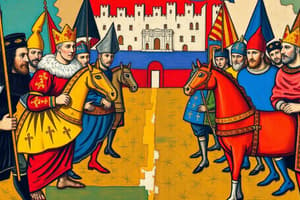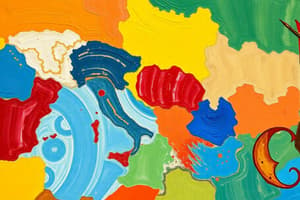Podcast
Questions and Answers
After the Treaty of Verdun, what happened to Charlemagne's kingdom?
After the Treaty of Verdun, what happened to Charlemagne's kingdom?
Charlemagne's three grandsons broke up the kingdom.
What was the main factor leading to the rise of European feudalism?
What was the main factor leading to the rise of European feudalism?
Constant warfare and political turmoil.
What is the name of the Scandinavian region where the Vikings originated?
What is the name of the Scandinavian region where the Vikings originated?
Scandinavia.
What was the main reason for the decline of Viking raids in Europe?
What was the main reason for the decline of Viking raids in Europe?
The Magyars were a peaceful nomadic group that settled in Europe.
The Magyars were a peaceful nomadic group that settled in Europe.
What was the main strategy employed by the Muslims in their conquest of Europe?
What was the main strategy employed by the Muslims in their conquest of Europe?
What was the main reason people began to rely on local rulers during the Viking invasions?
What was the main reason people began to rely on local rulers during the Viking invasions?
What is the name of the agreement between Rollo, the Viking leader, and Charles the Simple, the King of France?
What is the name of the agreement between Rollo, the Viking leader, and Charles the Simple, the King of France?
What does 'fief' refer to?
What does 'fief' refer to?
Who are the individuals who fight for a lord in exchange for protection and a fief?
Who are the individuals who fight for a lord in exchange for protection and a fief?
What is the name for the people who cultivate the land for the lord and cannot leave the land?
What is the name for the people who cultivate the land for the lord and cannot leave the land?
What was the basic economic unit within feudal society?
What was the basic economic unit within feudal society?
What types of tasks did peasants perform for their lords?
What types of tasks did peasants perform for their lords?
Peasants were allowed to leave the manor at any time.
Peasants were allowed to leave the manor at any time.
What are the two main taxes that peasants had to pay?
What are the two main taxes that peasants had to pay?
The manor was a self-sufficient community, meaning that most of the goods and services needed were produced within the manor itself.
The manor was a self-sufficient community, meaning that most of the goods and services needed were produced within the manor itself.
What was the main reason for the decline in trade during the early Middle Ages?
What was the main reason for the decline in trade during the early Middle Ages?
What was the role of the church in medieval society?
What was the role of the church in medieval society?
What was the name of the tax that peasants paid to the church?
What was the name of the tax that peasants paid to the church?
What best describes the living conditions of ordinary peasants in medieval Europe?
What best describes the living conditions of ordinary peasants in medieval Europe?
What was the main source of income for most peasants?
What was the main source of income for most peasants?
What was the average life expectancy of medieval peasants?
What was the average life expectancy of medieval peasants?
The Church supported the idea that a person's social standing was predetermined by God.
The Church supported the idea that a person's social standing was predetermined by God.
Flashcards
What is feudalism?
What is feudalism?
A political and economic system based on land ownership and personal loyalty, where a lord grants land to a vassal in exchange for military service and loyalty.
What is a fief?
What is a fief?
A grant of land from a lord to a vassal in exchange for loyalty and service.
What is a vassal?
What is a vassal?
A person who receives land (a fief) from a lord in exchange for loyalty and service.
What is a lord?
What is a lord?
Signup and view all the flashcards
What is a serf?
What is a serf?
Signup and view all the flashcards
What is a manor?
What is a manor?
Signup and view all the flashcards
What is a tithe?
What is a tithe?
Signup and view all the flashcards
What is a knight?
What is a knight?
Signup and view all the flashcards
What is the Middle Ages?
What is the Middle Ages?
Signup and view all the flashcards
How did feudalism develop?
How did feudalism develop?
Signup and view all the flashcards
Who were the main invaders of Europe during the 800s?
Who were the main invaders of Europe during the 800s?
Signup and view all the flashcards
What were the obligations of a peasant to the lord of the manor?
What were the obligations of a peasant to the lord of the manor?
Signup and view all the flashcards
What were the three main social classes in the feudal system?
What were the three main social classes in the feudal system?
Signup and view all the flashcards
How were the Vikings different from earlier Germanic groups that invaded Europe?
How were the Vikings different from earlier Germanic groups that invaded Europe?
Signup and view all the flashcards
How was a manor self-sufficient?
How was a manor self-sufficient?
Signup and view all the flashcards
What benefits did a medieval manor provide to the serfs who lived there?
What benefits did a medieval manor provide to the serfs who lived there?
Signup and view all the flashcards
Study Notes
Feudalism in Europe
- Feudalism was a political and economic system based on land ownership and personal loyalty, emerging in Europe after the Treaty of Verdun.
- Charlemagne's grandsons divided his kingdom which led to further conflict.
- From roughly 800-1000, invasions, like those by Muslims, Magyars, and the Vikings, weakened the Carolingian Empire.
- Muslim invaders attacked Italy and Sicily. Magyars raided Germany and Italy. Vikings attacked from Scandinavia and England.
- Vikings used longboats, which were nimble ships capable of deep-water and shallow-water travel, which enabled them to raid coastal villages and monasteries. These invasions made kings unable to defend their lands.
A New Social Order: Feudalism
- Local rulers gained followers by defending their people, taking control.
- Rollo, a Viking leader, was granted land in exchange for loyalty to the French king, leading to the creation of Normandy.
- Feudalism involved an agreement between a lord (landowner) and vassal (person receiving land), where vassals pledged loyalty and military service in return.
- Feudal society had a hierarchical structure (pyramid) : King at the top, followed by powerful vassals, then knights, and finally peasants/serfs at the bottom.
- Knights were mounted horsemen who protected the lands of their lords.
- Peasants/serfs worked the land, and their labor belonged to their lord. Landless peasants worked the fields for the nobles. This system of obligations and rights was a key element in medieval Europe.
Manors: The Economic Side of Feudalism
- Manors were the estates of lords during the Middle Ages.
- Manors were largely self-sufficient economies.
- Peasants worked the manor lands, providing labor and goods in return for housing, farmland and protection from bandits.
- Peasants paid taxes in exchange for maintaining the lord's estate.
- Peasants lived a simple life, often within a few miles of their homes.
The Medieval Manor
- A typical medieval manor included a manor house, church, workshops, a village, and surrounding fields and woodland.
- The lord's land, called the demesne, was worked by serfs to provide food and resources for the manor.
- The manor was largely self-sufficient; with animals, crops, and crafts, most needs were met locally.
- The harsh realities of peasant life involved long days of work, difficult conditions, and high taxes.
Studying That Suits You
Use AI to generate personalized quizzes and flashcards to suit your learning preferences.




